Company Overview
Price Technologies (Price) is a startup that is using machine learning and AI to build what it describes as the most advanced matching technology in the world. The company’s vision is to become the “matching operating system” by matching anything with everything online.
Price helps online retailers implement innovative product-matching technology application. The company licenses its technology to some of the largest retailers and industry players in the world, which benefit from a new source of traffic, more relevant search results, additional engagement and increased retention.
Price’s e-commerce application, Price.com, bridges the gaps among online marketplaces by providing consumers with complete transparency. Price.com is currently in beta mode and is expected to officially launch in early 2019. The technology can identify new, used, refurbished, unbranded and rental options for any item that is sold online that a consumer may be looking for. It provides users with complete price transparency and helps shoppers select the product that best suits their needs, while also helping them maximize their savings. Price.com leverages product-matching technology and data collected daily from more than 2,000 retail partners offering more than 150 million unique products.
Price offers retailers innovative matching technology applications, pricing strategies and catalog intelligence, including:
- Innovative matching technology applications: Price helps online retailers implement innovative product-matching applications such as visual and voice search and browser extensions:
- The company’s visual search offering uses image recognition technology to enable shoppers to discover product similar to those they see in a photo (including on social media) that can be purchased online, linking the image to relevant items at that retailer.
- Price’s white-label browser extension allows retailers to drive traffic from any site to their own site. It works via Chrome, Firefox and Safari, and across thousands of sites.
- The company’s white-label chatbot enables product matching through chat.
- Price’s matching API can help retailer’s voice search applications to match a shopper’s words or voice commands with relevant items at that retailer.
- Pricing strategies: Price.com helps guide shoppers’ decisions by providing suggested pricing and predictive pricing for the fair market value of any used product.
- Catalog intelligence: Price offers companies catalog normalization and automatic taxonomization capabilities.
Price believes that its technology has many use cases in industries beyond e-commerce.
 Source: Price Technologies/Coresight Research
Source: Price Technologies/Coresight Research
Price.com: Milestones
Price.com is the brainchild of computer scientist and tech entrepreneur RJ Jain, who says that he wanted to enable shoppers to see all the purchasing options available across online marketplaces in one place. Jain says that he conceived the idea after buying a dining room table and then finding the same item for less than half the price on a used product marketplace the next day. Jain developed Price.com to give shoppers a tool to avoid such costly but common mistakes.
Jain previously cofounded Appurify, a platform that solves the challenge mobile developers face when developing applications for multiple devices that use different operating systems. The company was later acquired by Google. Jain saw parallels between the fragmentation of operating systems across mobile devices and the fragmentation across online marketplaces. Price.com was designed to reduce that fragmentation by displaying all purchasing options to shoppers, increasing transparency and purchasing confidence.
Price was founded in 2016 and has raised a seed round of funding totaling $4 million. The company released Price.com in beta in 2017 and signed its first licensing contract in July 2018.
 Source: Price Technologies
Source: Price Technologies
Company Offering
Price.com uses matching technology to provide consumers with transparency, enabling them to instantly shop across online marketplaces for any product they are looking for. Price.com shows all the marketplaces where the item is available for sale—whether new (such as on Amazon), used and available locally (for example, on Facebook Marketplace or Letgo) or refurbished—as well as sites where the item is available for rental (such as Rent the Runway or Fat Lama).
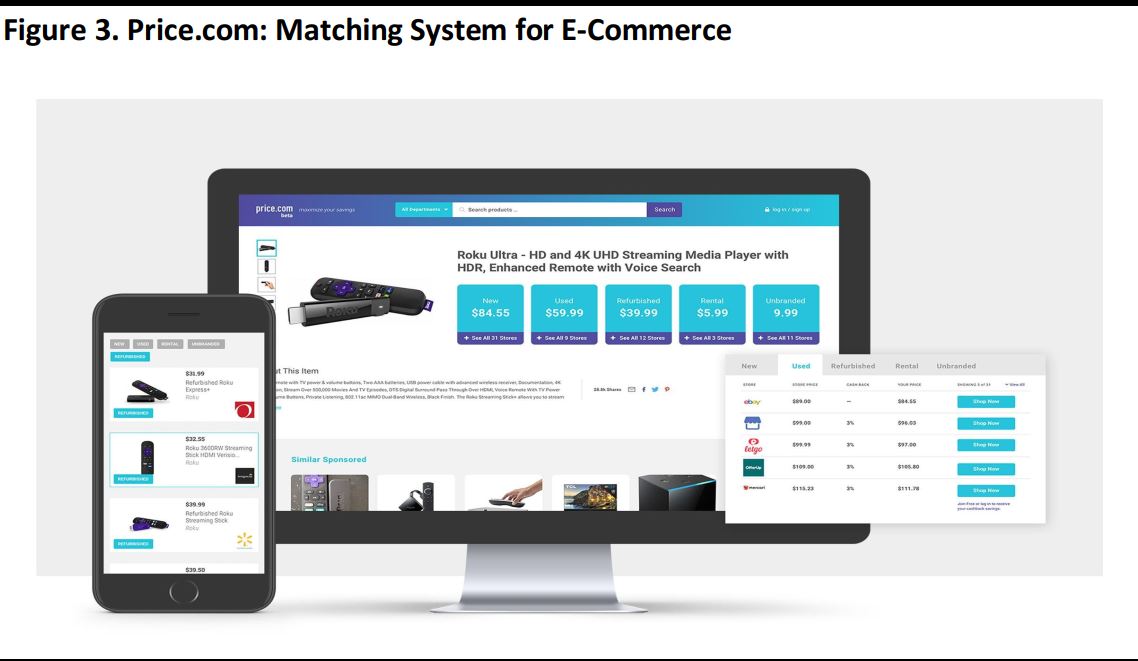 Source: Price Technologies
Source: Price Technologies
With one click, shoppers using Price.com can generate comprehensive search results that show purchase and rental options for a product. Shoppers can then choose from among the top marketplaces that offer new, used, unbranded and local products for sale or rent.
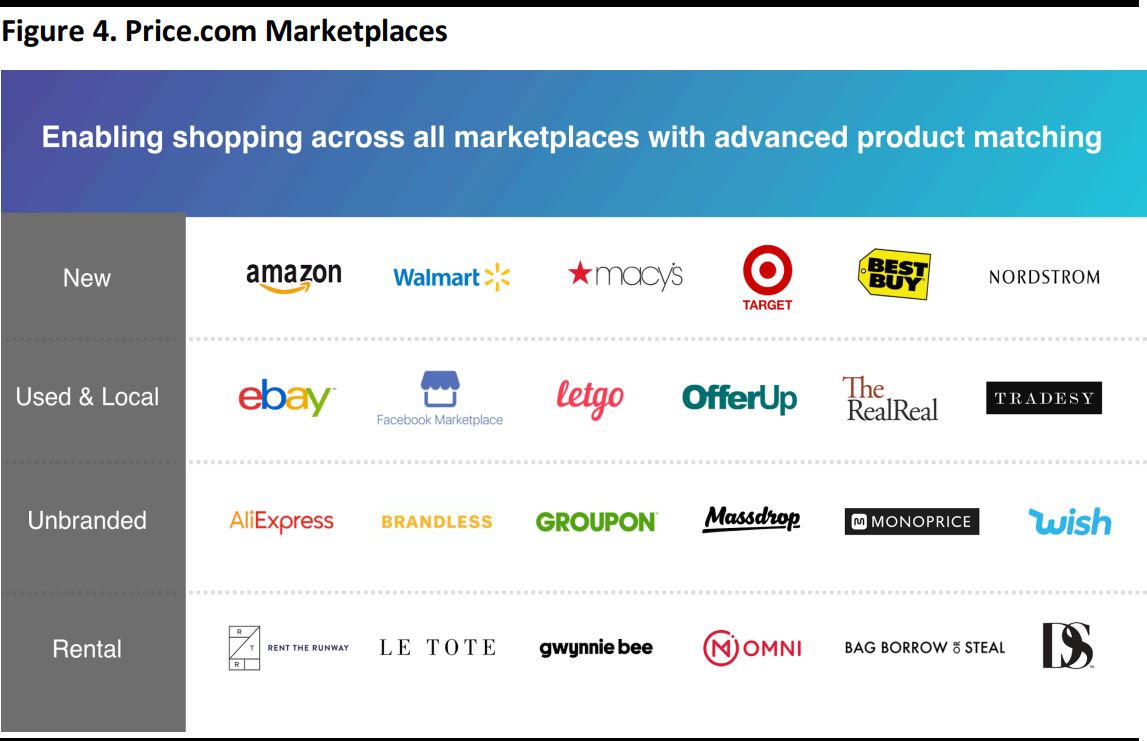 Source: Price Technologies
Source: Price Technologies
Shoppers can access Price.com via native app, browser extension, chatbot or website:
- iOS app: The Price.com app enables users to easily shop across all online marketplaces. To see a holistic view of all their shopping options, users simply search for a product, scan a barcode, take a picture with the app, or, while shopping on another app, share the product to the Price.com app.
- Browser extension: Once the browser extension is installed, shoppers can browse the websites of their favorite online retailers and marketplaces, then simply click a button on a product page to see all relevant product matches across all marketplaces.
- Chatbot: The Price.com chatbot integrates seamlessly with Facebook Messenger. Price describes its chatbot as “the world’s most comprehensive AI-powered shopping assistant.” Users can copy and paste the URL of an item they are interested in or upload a picture to the chatbot and instantaneously receive relevant matching results from all marketplaces.
- Website: Visitors to the Price.com website can search any product or URL, or upload a picture, to shop for the product across all marketplaces. Price also scans the Internet for products with the best reviews and provides users with a full view of all their shopping options for these top-reviewed products.
Price.com collects data on hundreds of millions of products from more than 2,000 retailers, then normalizes and automatically taxonomizes this data to the highest level of categorization. The company then uses natural language processing to match products across platforms according to more than 20 attributes, including SKU, title and description. Price uses advanced image analysis to enhance the final matched results.
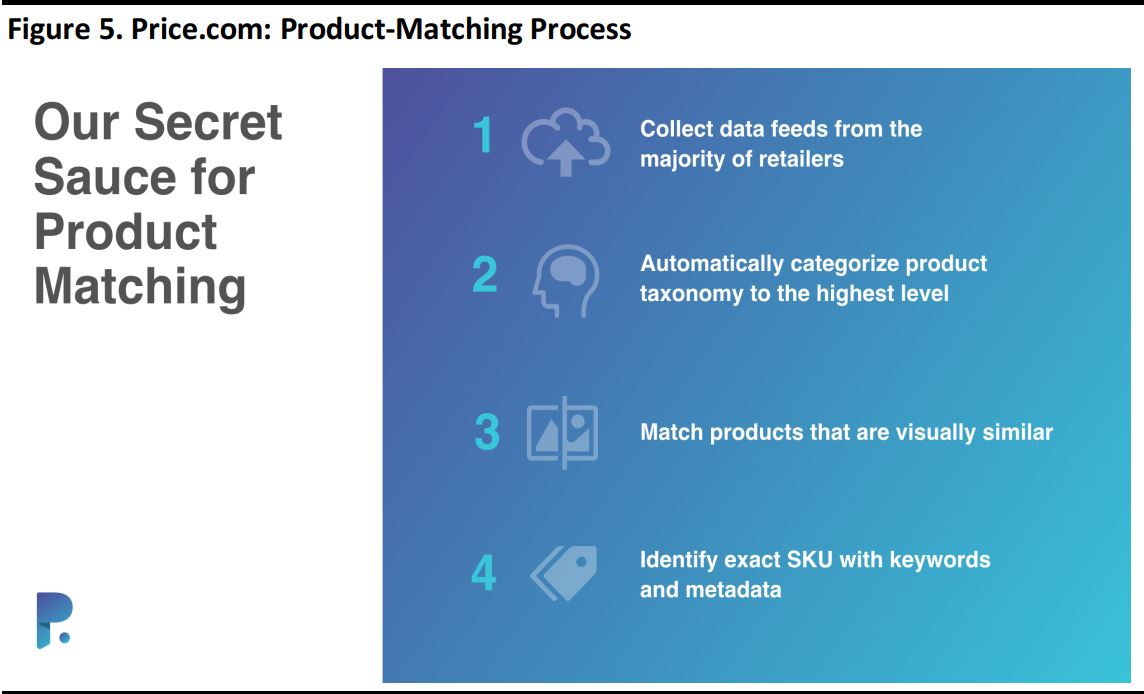 Source: Price Technologies
Source: Price Technologies
Price.com’s product categorization methodology enables shoppers to perform fast and accurate searches. One of the biggest challenges for e-commerce aggregators is that the marketplaces from which they pull product listings can define categories differently. To standardize categories across retailers and marketplaces, Price.com developed a universal taxonomy that is based on the different shopping taxonomies from Google and other retailers and that maps product titles using machine learning. Price.com also leverages AI, as well as its huge database of hundreds of millions of products, to correctly match currently available products across a range of independent marketplaces.
Price uses natural language processing to read and understand detailed product descriptions and extract the most relevant details, just the way a human might if she could read millions of descriptions at once. This enables the creation of an automated taxonomy of items, allowing the platform to provide shoppers with options for products that exactly match the one they searched for or are highly similar. For example, Price.com can provide a shopper who is searching for a couch from Wayfair with couches from Restoration Hardware that have the same product specifications.
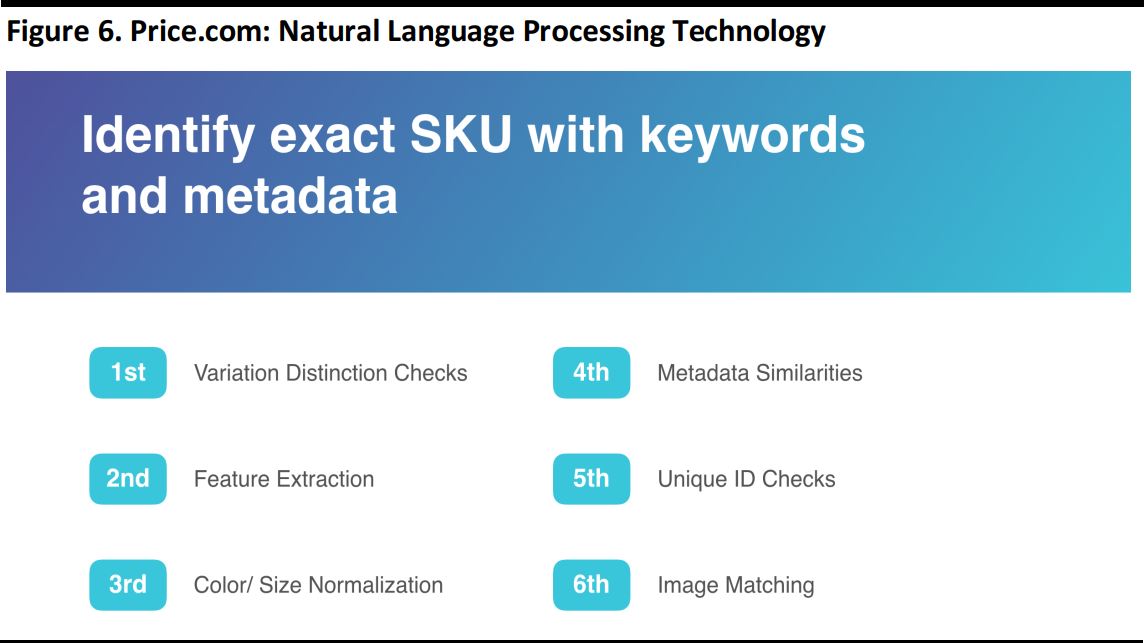 Source: Price Technologies
Source: Price Technologies
Price also uses advanced image analysis to find visually similar products. When a shopper sees a photo and thinks, “I’ve seen a bag that looks just like that one,” the technology can identify where she can buy or rent the product.
 Source: Price Technologies
Source: Price Technologies
By combining all the information, descriptions, images and standardized codes that are available, Price can correctly categorize products, compare identical items across shopping platforms, and find exact or similar products to meet a range of shopping needs.
Industry Overview
Price.com operates within the e-commerce industry, a large and dynamic sector that had a total global value of $1.4 trillion in 2017 and that is estimated to grow at a CAGR of 15% through 2022, to $2.8 trillion, according to Euromonitor International.
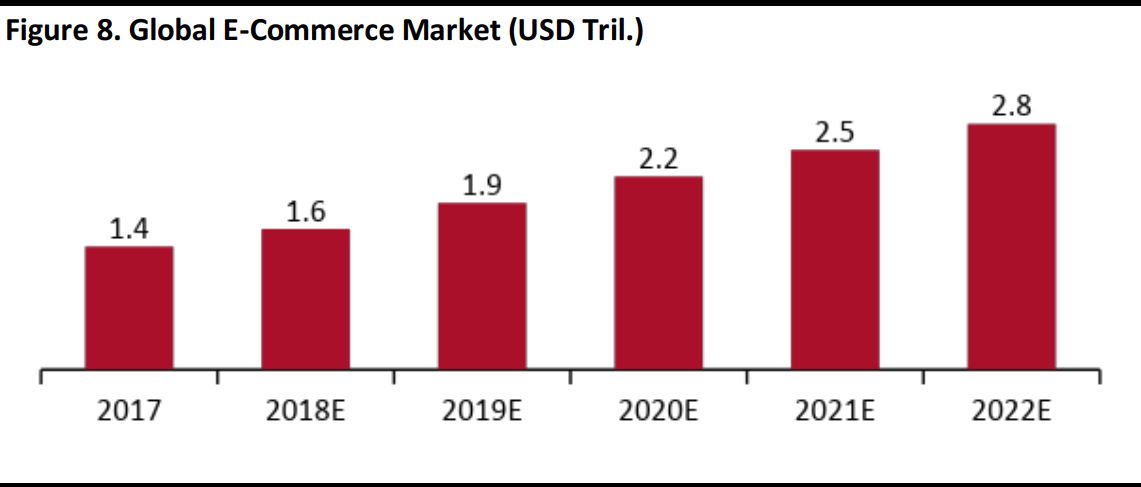 Source: Euromonitor International/Coresight Research
Source: Euromonitor International/Coresight Research
Marketplace sales—transactions between a third-party company or brand and consumers via an online platform such as Amazon or eBay—are increasingly driving e-commerce. According to Euromonitor, marketplace sales accounted for 41% of all online retail sales in 2017, up from 17% in 2008. Amazon and other major e-commerce retailers have begun relying more heavily on such sales. In 2007, third-party sellers accounted for only 26% of all units sold on Amazon, but that figure has risen to 53% today.
Within e-commerce, Price.com enables shoppers to browse for new, used and rental products on specialized marketplaces, which are evolving rapidly and seeing significant growth as shoppers’ behavior and preferences shift.
Re-Commerce
Re-commerce, which refers to online product resale, is a thriving segment, thanks to the emergence of mobile peer-to-peer platforms that offer innovative and easy-to-use features, including social media functionality. This evolution has shifted resale away from traditional thrift shops.
Alternative marketplaces, such as re-commerce sites, are showing faster growth than retail overall. The figure below shows the projected growth of the broader apparel retail category versus apparel resale between 2017 and 2022.
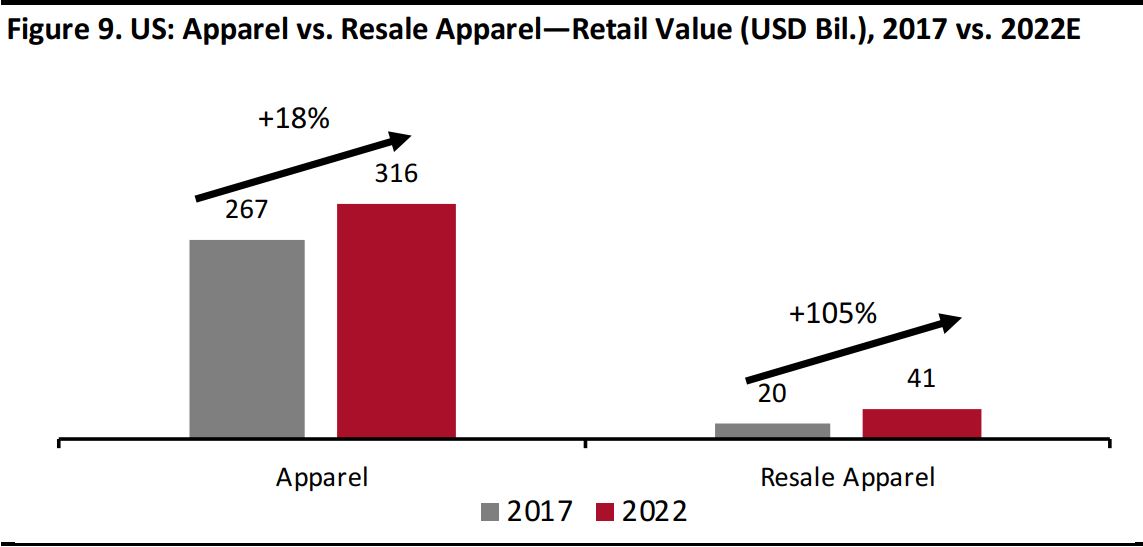 Source: Euromonitor International/ThredUP/Coresight Research
Source: Euromonitor International/ThredUP/Coresight Research
In its most innovative forms, re-commerce shows even stronger dynamism. For example, re-commerce disruptors—companies such as ThredUP, The RealReal and Poshmark—are growing 24 times faster than the broader apparel retail category, according to the
ThredUP 2018 Resale Report. Within re-commerce, apparel is the largest category, and it will make up 49% of total US re-commerce sales in 2018, according to ThredUP estimates.
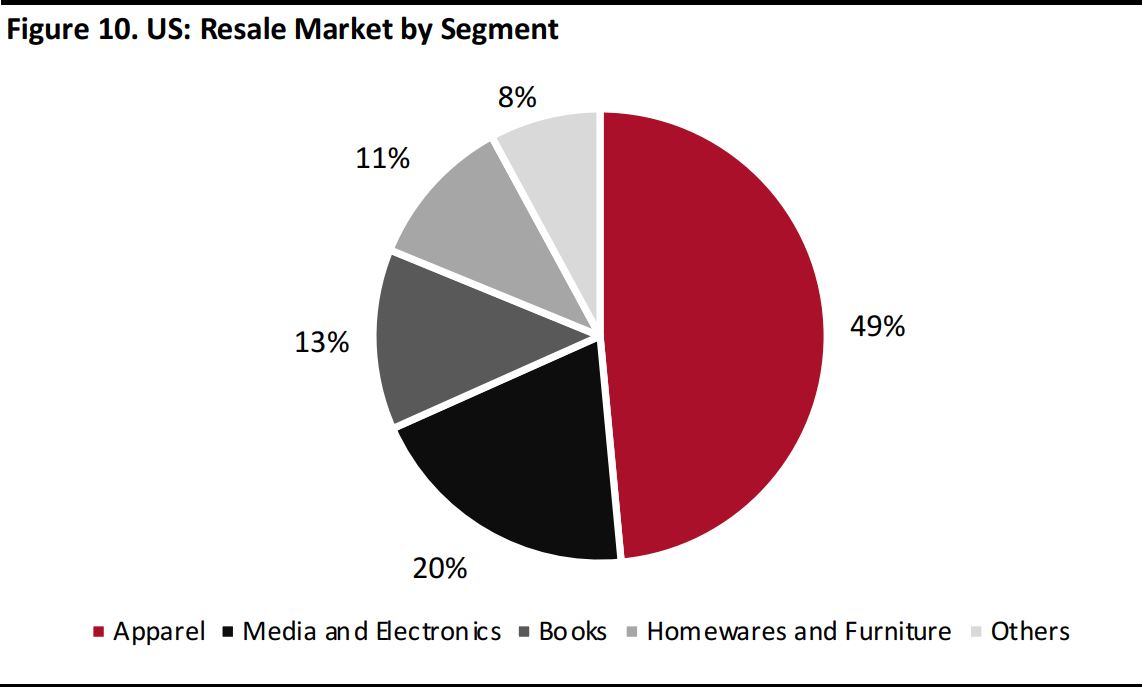 Figures do not sum to 100% due to rounding.
Source: ThredUP/Coresight Research
Figures do not sum to 100% due to rounding.
Source: ThredUP/Coresight Research
Aside from the emergence of digital channels for buying secondhand items, several other factors have been contributing to the growth of re-commerce:
- Generational change: According to ThredUP, millennials and women over 65 are the two demographic groups most likely to shop for secondhand items.
- Greater interest from higher-income shoppers: Millionaires make up 13% of the most active shoppers on ThredUP, according to the company.
- Environmental concerns: Fully 77% of millennial consumers prefer environmentally conscious brands, according to ThredUP. Resale is seen by many as an antidote to the negative impacts that hyper consumption and disposable fashion have on the environment, as clothes that are resold are recycled rather than sent to landfills and none of the resources required to produce new merchandise are used.
- Value and cost savings: Some 66% of consumers say that they secondhand shop in order to buy more premium brands that they would not have bought otherwise at full price, according to ThredUP.
- Decluttering: The average American woman does not wear 70% of the items in her closet, according to ThredUP.
Rental
Millennials are also driving the growth of the rental segment—and fashion rental in particular. The fashion rental segment is growing strongly and online apparel and accessories rental startups have proliferated as the sharing economy—which sees consumers forgoing ownership of products and choosing to rent, barter for or borrow them instead—has grown. The online clothing rental market is expected to grow at an 11% CAGR from 2017 through 2023, to reach $1.9 billion globally, according to research company Allied Market Research.
 Source: Allied Market Research/Coresight Research
Source: Allied Market Research/Coresight Research
Rental companies such as Rent the Runway appeal to millennial shoppers by making aspirational, designer products affordable for many who do not have the means to purchase such items. According to a 2017 survey by shopping-center operator Westfield, about 46% of millennials in the UK and 35% in the US would be willing to spend £200 ($253) or more monthly to rent clothes.
Three key millennial lifestyle trends are underpinning the development of the rental segment: a desire to be seen wearing an ever-changing, on-trend wardrobe that is influenced by social media and celebrity culture, a preference for spending on experiences rather than on goods, and frugal consumption habits.
The rental segment can have a positive impact on retailing, as it can inspire consumers to make purchases once they have tried a certain item or brand. Rental services are a means of introducing potential customers to new brands and designers, especially ones that the renters may not be able to afford to buy outright: according to Rent the Runway, 95% of apparel renters are trying a brand for the first time. In some instances, customers would likely never have tried the brand if the apparel rental service had not been available.
Software-Licensing Market
Within the business-to-business sector, Price Technologies operates in the software-licensing market, offering retailers solutions that include visual search technology, white-label browser extensions, chatbots and catalog intelligence.
Software licensing is a fast-growing sector that is driven by rapid developments in technology. The global software-licensing market is expected to grow at a 9% CAGR from 2017 through 2023, to reach $14 billion, according to research firm Market Research Future.
 Source: Market Research Future/Coresight Research
Source: Market Research Future/Coresight Research
Large players in the software-licensing space include tech giants Amazon and Google, which are driving the growth of the market with cloud and office productivity services such as Amazon Web Services (AWS) and Google G Suite. There are parallels between Price.com and the two tech giants, as all three companies’ online portals are used as a tool by shoppers to inform their e-commerce journeys.
How Shoppers Inform Their Online Shopping Journey
Price believes that it has no direct competitors, as no other platform provides the level of services that Price.com offers to shoppers starting their online journey. Amazon and Google can be considered indirect competitors, as shoppers tend to start their online shopping journey from marketplaces or search engines that they think are comprehensive enough to highlight the best shopping options.
The figure below shows that the majority of shoppers start their online shopping journey on Amazon. In a 2018 survey undertaken by Censuswide for e-commerce consultancy Salmon, 51% of respondents said that they start their shopping journey on Amazon. Google was the second-most-popular starting point among those surveyed, but the popular search engine was chosen by only 16% of respondents.
 Base: 3,516 consumers ages 18–64 who had shopped online at least once in the last month; 2,016 and 1,500 respondents from the UK and the US, respectively, were interviewed online during April 2018.
Source: Salmon/Censuswide
Base: 3,516 consumers ages 18–64 who had shopped online at least once in the last month; 2,016 and 1,500 respondents from the UK and the US, respectively, were interviewed online during April 2018.
Source: Salmon/Censuswide
Amazon is considered a benchmark for pricing, and many shoppers use the marketplace to compare prices before making a buying decision. The Salmon/Censuswide survey found that price was the most important factor in informing respondents’ buying decisions when shopping online, with 64% of those surveyed citing it as important. But among respondents who said that they start their shopping journey on Amazon, only 55% said that they are likely to buy from the platform.
Meanwhile, 80% of those who said that they start their shopping journey on Amazon said that they use the website as a tool to get information such as product reviews and pricing when shopping on other sites or in-store. So, despite the fact that more than half of shoppers use Amazon to start their online shopping journey, only a slightly higher percentage finish their journey on the platform, according to the Salmon/Censuswide survey. Others go elsewhere for reasons that include cheaper prices, more attractive loyalty programs or more convenient delivery options.
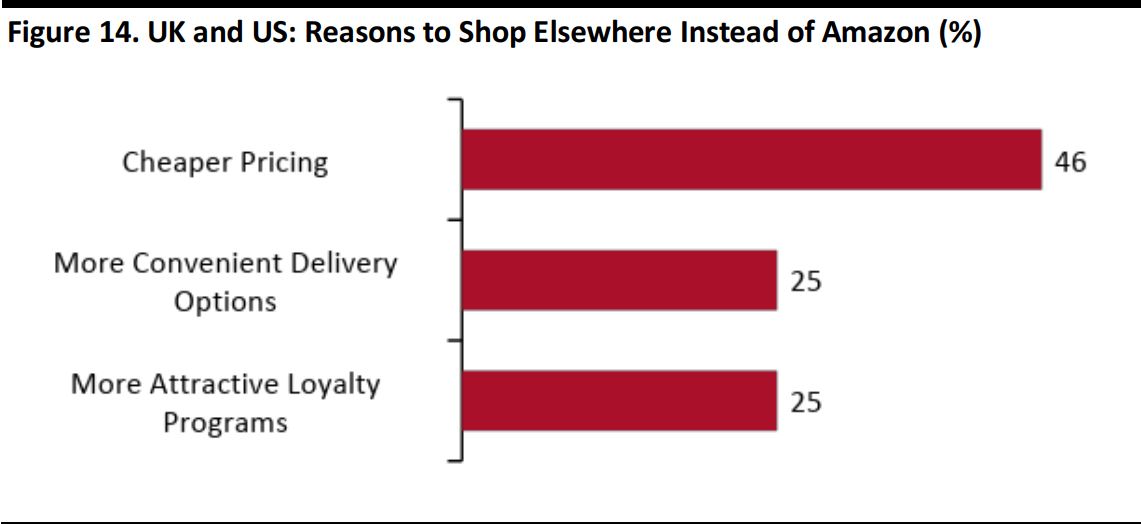 Base: 3,516 consumers ages 18–64 who had shopped online at least once in the last month; 2,016 and 1,500 respondents from the UK and the US, respectively, were interviewed online during April 2018.
Source: Salmon/Censuswide
Base: 3,516 consumers ages 18–64 who had shopped online at least once in the last month; 2,016 and 1,500 respondents from the UK and the US, respectively, were interviewed online during April 2018.
Source: Salmon/Censuswide
The findings of the survey highlight a gap in the market: consumers are using Amazon to inform their shopping journey, but they are using a tool made for other purposes. That is, the shopping platform is not designed to showcase the best shopping options based on a shopper’s individual requirements.
Price.com fills that gap, helping shoppers navigate online marketplaces by highlighting the best shopping options for them. This enables shoppers to save time and find what they are looking for, whether their top criteria include pricing, promotions, delivery options or other factors. Price says that shoppers can achieve superior results by starting their shopping journey with Price.com because it gives them a tool designed to help them find what they want. Price.com benefits the retailing industry as a whole by encouraging purchases and reducing the number of searches that result in shopping cart abandonment.
Competitive Advantages
Price considers its Price.com solution to be the most advanced product-matching and identification technology available. The company believes that it has no direct competitors, as no other platform provides the level of services that Price.com offers to shoppers starting their online journey. The figure below plots Price.com’s competitive advantage matrix, highlighting the platform’s positioning and growth opportunities.
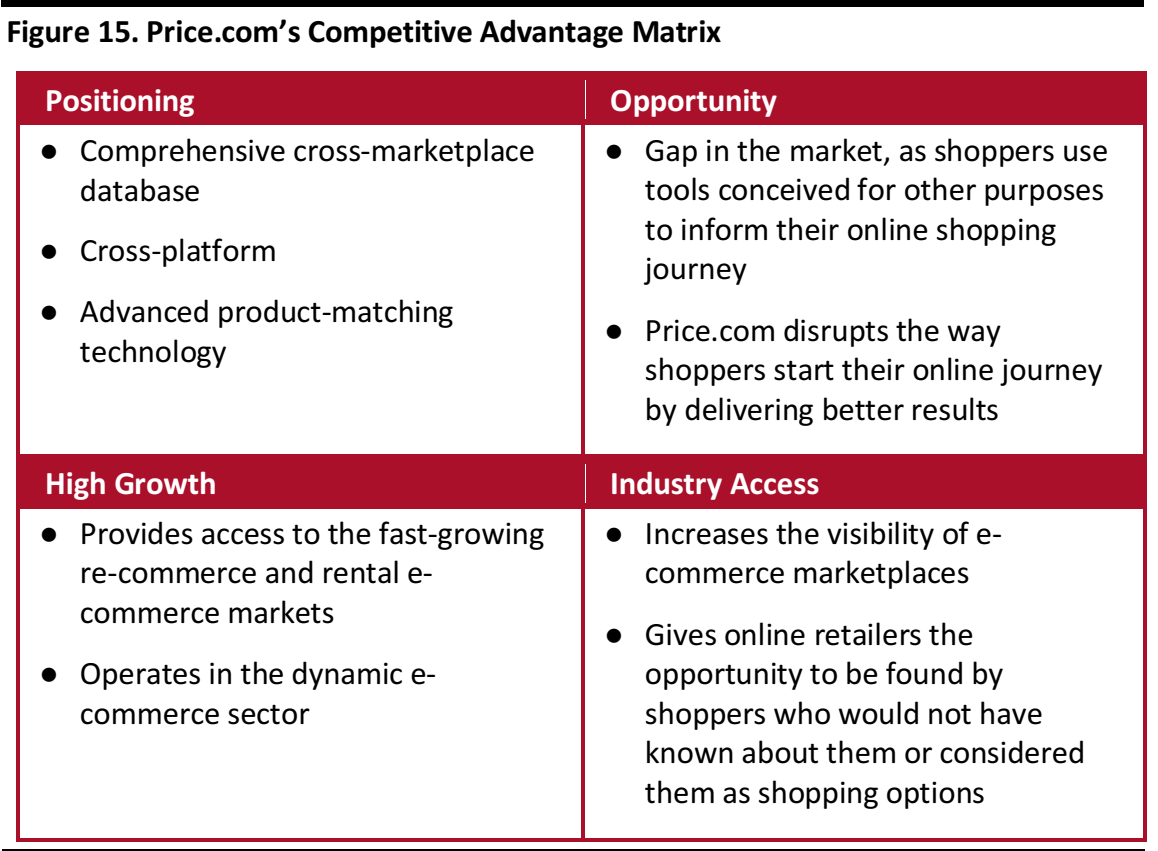 Source: Coresight Research
Source: Coresight Research
Case Study: Other World Computing
The largest seller of aftermarket Mac parts, Other World Computing, is applying Price’s technology to its e-commerce operations, with a specific focus on search relevancy. The technology is helping drive consumers back to the company’s shopping destination site. The objective is to use Price’s matching technology to enable consumers to find the exact part or accessory that they are looking for while browsing any other site, and then drive them to finish the purchase on the Other World Computing site.
Price is also working with some of the largest retailers in the world to license its technology. The figure below shows selected companies that are currently collaborating with Price and some that are expected to license its technology in the near future.
 Source: Price Technologies
Source: Price Technologies
Business Model
Price generates revenue through the licensing of its software, extension technology, visual search technology and application programming interface (API) browser extension, as well as through direct and affiliate cost-per-click/cost-per-action lead generation.
 Source: Price Technologies
Source: Price Technologies
Go-to-Market Strategy
Price has a cross-platform go-to-market strategy that includes website, app, chatbot and browser extension offerings. The platforms work together to create a number of tools for consumers. The domain “Price.com” provides the company with search engine optimization benefits and brand awareness. On the licensing side, Price has developed substantial relationships with top retailers and is working with channel partners for maximum reach.
Price’s investors include venture capital firm Founders Fund, which invests in companies building revolutionary technologies and which has helped PayPal, Facebook, Space Exploration Technologies (SpaceX) and Palantir Technologies grow, and individual investors with leadership roles at tech giants such as Twitter, Pinterest, Microsoft and Facebook.
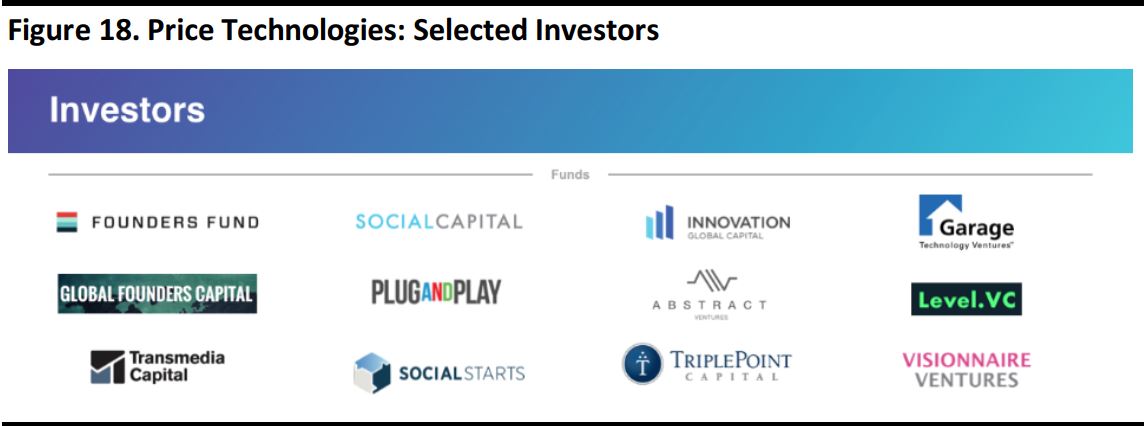 Source: Price Technologies
Source: Price Technologies
Competitive Landscape
Price considers marketplace aggregator service Google Shopping to be the closest competitor to Price.com. Amazon is the other
de facto competitor, as shoppers tend to start their online shopping journey on either Amazon or Google. However, Google and Amazon have a different focus, and Price believes that no other suite can match the product-matching and identification capabilities offered by Price.com. The figure below shows the features and capabilities that differentiate Price.com from competitors.
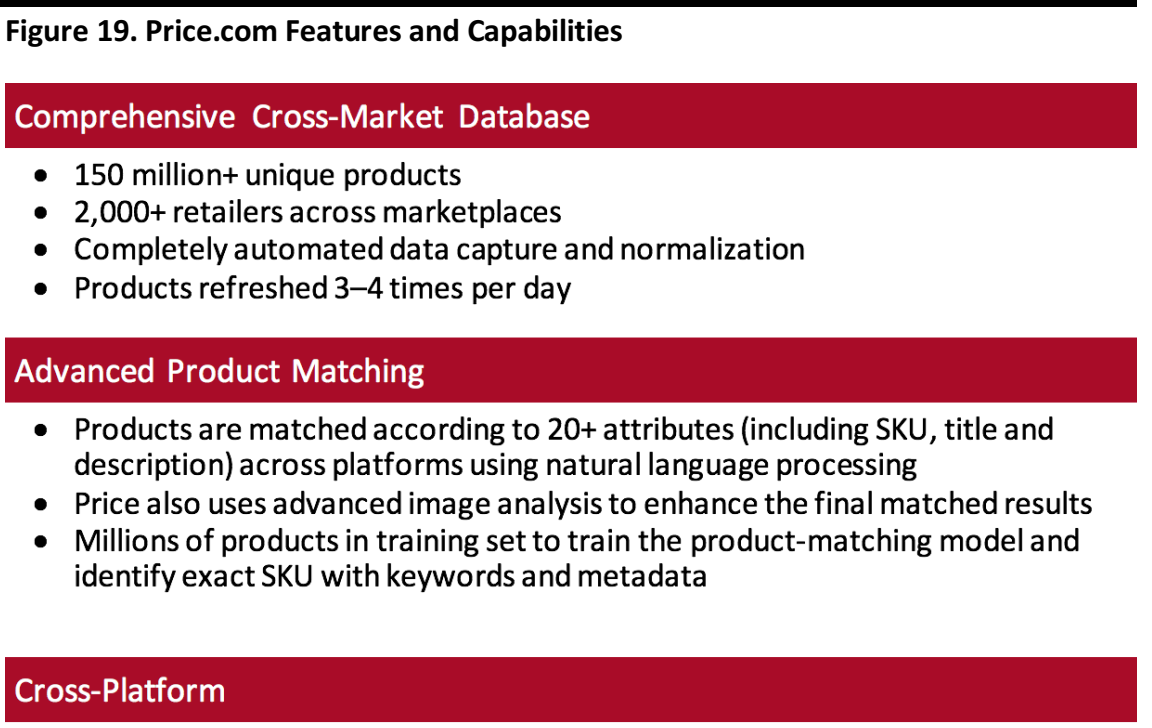 Source: Price Technologies/Coresight Research
Source: Price Technologies/Coresight Research
Key Management
Computer scientist and entrepreneur RJ Jain is the Founder, CEO and CTO of Price. Jain previously cofounded and sold to Google mobile test automation and optimization company Appurify, which currently powers Google Test Labs. He also formerly served as Director of Engineering at Sidecar (which was later bought by GM), as Senior Engineer at Zynga and as Entrepreneur in Residence at Foundation Capital.
The company’s core leadership team includes experts in AI and machine learning: Lead Engineer Sean Jones, Head of Data Engineering Saurabh Kumar (former head of data engineering at Walmart), Data Engineer Bhushan Jain (former senior data engineer at Overstock.com), Senior Data Scientist Genevieve Graves (former chief data scientist at hiQ labs) and Senior Data Engineer Dan Miller.
 Source: Price Technologies
Source: Price Technologies
Company Outlook/Upcoming Announcements
Price’s strategy is to continually enhance its matching software, expand its licensing business and fully roll out Price.com for consumers next year.
Coresight Research View
There is a gap in the e-commerce market, as shoppers have no established tool to use to inform their online shopping journey. Consumers who use Amazon and Google to find what they are looking for when shopping online risk obtaining suboptimal results, as neither platform was designed to scoop and present shopping options from a comprehensive range of marketplaces.
Price.com fills that gap by delivering a platform that reduces fragmentation and increases transparency and purchasing confidence by displaying all purchasing options—including new, used, local, unbranded and rental products—to shoppers.
Price.com has substantial growth potential, as it unleashes shopping options in re-commerce and rental. These two sectors are disrupting e-commerce as shoppers’ environmental concerns grow and as younger generations’ shopping preferences shift. Some of the largest retailers in the world are already benefiting by licensing Price’s AI- and machine learning–powered matching technology, but it has applications beyond retail: the company’s technology can also be used for applications in industries such as pharmaceuticals, science and engineering, exponentially expanding Price’s growth opportunities.
We think that the growth of a platform such as Price.com, which boosts shoppers’ confidence and empowerment, will be beneficial to the retail industry as a whole, resulting in greater sales conversion and reduced shopping cart abandonment.
Company Contact
RJ Jain, Founder, CEO and CTO
rj@price.com
https://price.com/

 Source: Price Technologies/Coresight Research
Source: Price Technologies/Coresight Research Source: Price Technologies
Source: Price Technologies Source: Price Technologies
Source: Price Technologies Source: Price Technologies
Source: Price Technologies Source: Price Technologies
Source: Price Technologies Source: Price Technologies
Source: Price Technologies Source: Price Technologies
Source: Price Technologies Source: Euromonitor International/Coresight Research
Source: Euromonitor International/Coresight Research Source: Euromonitor International/ThredUP/Coresight Research
Source: Euromonitor International/ThredUP/Coresight Research Figures do not sum to 100% due to rounding.
Source: ThredUP/Coresight Research
Figures do not sum to 100% due to rounding.
Source: ThredUP/Coresight Research Source: Allied Market Research/Coresight Research
Source: Allied Market Research/Coresight Research Source: Market Research Future/Coresight Research
Source: Market Research Future/Coresight Research Base: 3,516 consumers ages 18–64 who had shopped online at least once in the last month; 2,016 and 1,500 respondents from the UK and the US, respectively, were interviewed online during April 2018.
Source: Salmon/Censuswide
Base: 3,516 consumers ages 18–64 who had shopped online at least once in the last month; 2,016 and 1,500 respondents from the UK and the US, respectively, were interviewed online during April 2018.
Source: Salmon/Censuswide Base: 3,516 consumers ages 18–64 who had shopped online at least once in the last month; 2,016 and 1,500 respondents from the UK and the US, respectively, were interviewed online during April 2018.
Source: Salmon/Censuswide
Base: 3,516 consumers ages 18–64 who had shopped online at least once in the last month; 2,016 and 1,500 respondents from the UK and the US, respectively, were interviewed online during April 2018.
Source: Salmon/Censuswide Source: Coresight Research
Source: Coresight Research Source: Price Technologies
Source: Price Technologies Source: Price Technologies
Source: Price Technologies Source: Price Technologies
Source: Price Technologies Source: Price Technologies/Coresight Research
Source: Price Technologies/Coresight Research Source: Price Technologies
Source: Price Technologies